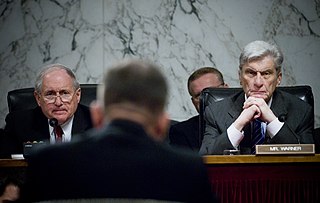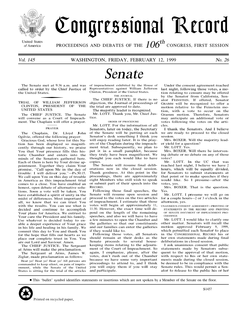
The Code of Laws of the United States of America is the official compilation and codification of the general and permanent federal statutes of the United States. It contains 53 titles. The main edition is published every six years by the Office of the Law Revision Counsel of the House of Representatives, and cumulative supplements are published annually. The official version of those laws not codified in the United States Code can be found in United States Statutes at Large.
An Act of Congress is a statute enacted by the United States Congress. Acts can affect only individual entities, or the general public. For a bill to become an act, the text must pass through both houses with a majority, then be either signed into law by the president of the United States or receive congressional override against a presidential veto.

The federal government of the United States is the national government of the United States, a federal republic in North America, composed of 50 states, a federal district, five major self-governing territories and several island possessions. The federal government is composed of three distinct branches: legislative, executive, and judicial, whose powers are vested by the U.S. Constitution in the Congress, the president and the federal courts, respectively. The powers and duties of these branches are further defined by acts of Congress, including the creation of executive departments and courts inferior to the Supreme Court.

An executive order is a means of issuing federal directives in the United States, used by the President of the United States, that manages operations of the federal government. The legal or constitutional basis for executive orders has multiple sources. Article Two of the United States Constitution gives the president broad executive and enforcement authority to use his or her discretion to determine how to enforce the law or to otherwise manage the resources and staff of the executive branch. The ability to make such orders is also based on expressed or implied Acts of Congress that delegate to the president some degree of discretionary power.

A congressional committee is a legislative sub-organization in the United States Congress that handles a specific duty. Committee membership enables members to develop specialized knowledge of the matters under their jurisdiction. As "little legislatures", the committees monitor ongoing governmental operations, identify issues suitable for legislative review, gather and evaluate information, and recommend courses of action to their parent body. Woodrow Wilson once wrote, "it is not far from the truth to say that Congress in session is Congress on public exhibition, whilst Congress in its committee rooms is Congress at work." It is not expected that a member of Congress be an expert on all matters and subject areas that come before Congress. Congressional committees provide valuable informational services to Congress by investigating and reporting about specialized subjects.

The Congressional Record is the official record of the proceedings and debates of the United States Congress, published by the United States Government Publishing Office and issued when Congress is in session. Indexes are issued approximately every two weeks. At the end of a session of Congress, the daily editions are compiled in bound volumes constituting the permanent edition. Chapter 9 of Title 44 of the United States Code authorizes publication of the Congressional Record.

The Archivist of the United States is the head and chief administrator of the National Archives and Records Administration (NARA) of the United States. The Archivist is responsible for the supervision and direction of the National Archives.

The United States Statutes at Large, commonly referred to as the Statutes at Large and abbreviated Stat., are an official record of Acts of Congress and concurrent resolutions passed by the United States Congress. Each act and resolution of Congress is originally published as a slip law, which is classified as either public law or private law (Pvt.L.), and designated and numbered accordingly. At the end of a Congressional session, the statutes enacted during that session are compiled into bound books, known as "session law" publications. The session law publication for U.S. Federal statutes is called the United States Statutes at Large. In that publication, the public laws and private laws are numbered and organized in chronological order. U.S. Federal statutes are published in a three-part process, consisting of slip laws, session laws, and codification.
The powers of the president of the United States include those explicitly granted by Article II of the United States Constitution as well as those granted by Acts of Congress, implied powers, and also a great deal of soft power that is attached to the presidency.
Congressional oversight is oversight by the United States Congress over the Executive Branch, including the numerous U.S. federal agencies. Congressional oversight includes the review, monitoring, and supervision of federal agencies, programs, activities, and policy implementation. Congress exercises this power largely through its congressional committee system. Oversight also occurs in a wide variety of congressional activities and contexts. These include authorization, appropriations, investigative, and legislative hearings by standing committees; which is specialized investigations by select committees; and reviews and studies by congressional support agencies and staff.

The National Emergencies Act (NEA) is a United States federal law passed to end all previous national emergencies and to formalize the emergency powers of the President.
The United States Congressional Serial Set began in 1817 as the official collection of reports and documents of the United States Congress. The collection was published in a "serial" fashion, hence its name. It has been described as the "nation's most treasured publication" and beloved by librarians as "part of their most valued holdings."
A United States congressional hearing is the principal formal method by which United States congressional committees collect and analyze information in the early stages of legislative policymaking.
The U.S. Congress in relation to the president and Supreme Court has the role of chief legislative body of the United States. However, the Founding Fathers of the United States built a system in which three powerful branches of the government, using a series of checks and balances, could limit each other's power. As a result, it helps to understand how the United States Congress interacts with the presidency as well as the Supreme Court to understand how it operates as a group.
Edict of government is a technical term associated with the United States Copyright Office's guidelines and practices that comprehensively includes laws, which advises that such submissions will neither be accepted nor processed for copyright registration. It is based on the principle of public policy that citizens must have unrestrained access to the laws that govern them. Similar provisions occur in most, but not all, systems of copyright law; the main exceptions are in those copyright laws which have developed from English law, under which the copyright in laws rests with the Crown or the government.
The law of Pennsylvania consists of several levels, including constitutional, statutory, regulatory and case law. The Pennsylvania Consolidated Statutes form the general statutory law.
A presidential directive, or executive action, is a written or oral instruction or declaration issued by the president of the United States, which may draw upon the powers vested in the president by the U.S. Constitution, statutory law, or, in certain cases, congressional and judicial acquiescence. Such directives, which have been issued since the earliest days of the federal government, have become known by various names, and some have prescribed forms and purposes. Presidential directives remain in effect until they are revoked, which the president is free to do. The classification of presidential directives is not easily done, as the distinction between the types can be quite arbitrary, arising from convenience and bureaucratic evolution, and none are defined in the Constitution. Furthermore, the different types may overlap. As one legal scholar put it: "it is a bit misleading to overclassify presidential directives as comprising separate and distinct 'types' just because they have different headings at the top of the first page." In terms of legal applicability, what matters is the substance of the directive, not the form, unless a certain kind of directive is specifically required by relevant statute.
Congressional archives consist of records and personal papers that document the history and activities of the United States Congress. The National Archives and Records Administration’s Center for Legislative Archives collects and preserves the official administrative and legislative records of the U.S. Senate and the U.S. House of Representatives. The personal papers of individual senators and representatives, broadly called congressional collections, are the private property of members of Congress. Many members choose to donate their papers to repositories where their records are preserved and made available to the public.







